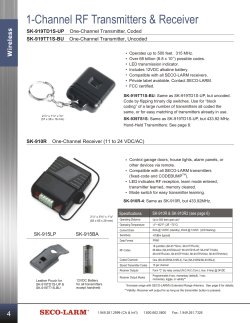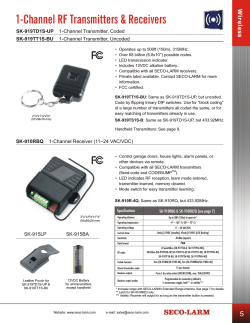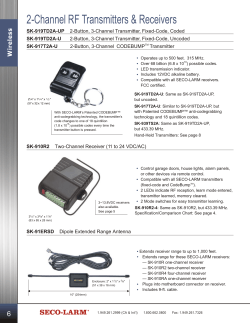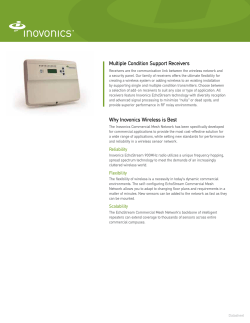
Distance Calculation by Using Bi-Section Algorithm with RFID Signals
3rd International Conference on Advances in Engineering Sciences & Applied Mathematics (ICAESAM’2015) March 23-24, 2015 London (UK) Distance Calculation by Using Bi-Section Algorithm with RFID Signals Baki KOYUNCU, Hakan KOYUNCU, Taner ÇELİK, and Sefika VARLIOGLU A numerical analysis technique is introduced in this paper to determine the distances between the source and the unknown object locations. This technique is called bi-section algorithm which is a root finding method. A range of distances with upper and lower limits is considered across the calibration curve. unknown object location with respect to source within this range is calculated by using bi-section algorithm and the best fit curve equation. In this paper, A theory of bi-section algorithm is given in section 2. In section 3, experiments and results are presented. Conclusions are given in sections 4. Abstract----RFID data in the form of LQI and RSSI values are collected at different distances from their sources. Data values are calibrated with respect to these distances. Unknown distance of a measurement point from a source can be calculated by using calibration curves. Bi-section algorithm is introduced with these calibration curves and the unknown measurement location is calculated automatically. MATLAB is used during the calculations. Keywords----RFID signals, Received signal strength indicator (RSSI), Link quality indicator (LQI), Bisection Algorithm I. INTRODUCTION İRELESS sensor nodes are introduced in localization in recent years. Radio frequency identification devices, RFIDs, are developed to find out the locations of unknown objects. RFIDs generate RF signals and radiate in all directions around them. These RF signal amplitudes are formatted in the form of received signal strength indicator (RSSI) values or Link Quality indicator ( LQI ) values when they are received by the receivers. Their utilisation is very easy in indoor or outdoor environment due to uniform spherical distribution of RF signals. They do not require any infra structure during transmission or reception [1, 2]. Many localization algorithms are introduced to use these LQI and RSSI values in literature [3,4 ]. In all these algorithms there is a need of distance information between RF source transmitters and the destination target object receivers. If an RFID source, acting as a transmitter, transmits RF signals; these signals radiate in spherical waves in all directions. A target object with an RFID receiver receives these signals in different signal amplitudes in the form of LQI and RSSI values. RF signal amplitudes attenuate with respect to increasing distances between the source and the target object. Their amplitudes decrease as the distance increases. It is possible to plot the RF signal amplitudes with respect to incremental distances between the source transmitter and the target receiver. A best fit curve among the distribution of RF signal amplitudes, identified as LQI or RSSI values, is plotted. This plot is called a calibration curve for a particular RF signal distribution with respect to distance. II. W a) LQI and RSSI values RF signals are effected from environmental conditions. These signals are attenuated and their amplitudes decrease with respect to distances. There are many signal propagation path loss models in the literature besides the free space propagation model [5]. According to free space transmission model, received signal strength is defined , as PRX PTX .GTX .GRX 4D 2 (1) PTX = transmission power, PRX = Receiver power, GTX = Gain of transmitter, GRX = Gain of receiver , = wavelegth d = Distance between transmitter and receiver. In some wireless sensor nodes, received signal amplitude is converted into RSSI values and it is given by RSSI 10. log PRX PREF dBm (2) where PRX is the received power and PREF is the reference power where PREF=1 mW. PRX decreases quadratically with the distance between the transmitter and receiver. In other wireless sensor nodes received signal amplitude is converted into Link Quality indicator (LQI) values. It is an indicator of the quality of signal packets received by the receiver [6]. Signal amplitudes are divided into 255 levels at RFID receiver and signal amplitudes are represented by these levels between 0 and 255. Baki KOYUNCU, Taner ÇELİK, Sefika VARLIOGLU, are with Computer Eng. Dept., Ankara University, Ankara, Türkiye. Hakan KOYUNCU is with Computer Science Dept,Loughborough University, England. Email Ids: bkoyuncu@ankara.edu.tr,h.koyuncu@lboro.ac.uk, tnr.celikk@gmail.com, sefikavarlioglu@gmail.com http://dx.doi.org/10.15242/IIE.E0315056 THEORY b) Bi-section algorithm Bi-section method is a Numerical analysis technique in mathematics [7]. It is a root-finding method that repeatedly bisects an interval and then selects a subinterval in which a root must lie in it. It is also named as a binary search method 64 3rd International Conference on Advances in Engineering Sciences & Applied Mathematics (ICAESAM’2015) March 23-24, 2015 London (UK) where the range of possible solutions is halved in each iteration. Assume a continuous distribution function F(x) for a real variable x. F(x) is a continuous function which is defined in between lower limit a and upper limit b where 0< a< b as shown in Figure 1. Fig. 1 A few steps of bi-section algorithm, circle is the root of the function and the interval is between a and b. F(x) must have minimum one root in interval (a, b). At each step, the algorithm divides the interval into 2 and finds the midpoint, c=(a+b)/2, and functon F(c) at mid point. If c is not a root which is unlikely; there are two possibilities; F(a) and F(c) have opposite signs and bracket a root or F(c) and F(b) have opposite signs and bracket a root. The method selects the subinterval to be used in the next step. Hence the interval that contains a zero of F(x) is reduced in width by 50% at each step. This continues until the interval is sufficiently small. If F(a) and F(c) are opposite signs, then the algorithm sets c as the new value for b, and if F(b) and F(c) are opposite signs then the method sets c as the new value for a. If F(c) = 0 then c may be taken as the solution and the process stops. In both cases, the new F(a) and F(b) have opposite signs, so the algorithm is repeated in this smaller interval. In this study, the input for the algorithm is the continuous function F(x) identified as the previously mentioned best fitted curve. The interval [a, b] is the range of LQI or RSSI measurements. F(a) and F(b) are the function values corresponding to a and b values. Each iteration performs the following steps: 1. Calculate c, the midpoint of the interval, c = 0.5 * (a + b). 2. Calculate the function value at the midpoint, F(c). 3. If (a – c)=0 or F(c)=0, c is taken as solution and stop iterating. 4. Examine the sign of F(c) and replace either (a, f(a)) or (b, f(b)) with (c, f(c)) so that there is a zero crossing within the new interval. Fig. 2 Flowchart of the Bisection Algorithm The method converges to a root of F(x) if F(x) is a continuous function between [a, b] and F(a) and F(b) have opposite signs. The absolute error is halved at each step so the method converges linearly. If c1 = (a+b)/2 is the midpoint of the initial interval, and c n is the midpoint of the interval in the nth step, then the difference between cn and a solution c is bounded by (3) Equation (3) can be used to predic the number of iterations that the bisection algorithm would converge to a root. The number of iterations, n, to achieve a given error ,ε, is given by: (4) where (5) Therefore, the linear convergence is given by (6) III. EXPERIMENTS & RESULTS Experiments are conducted in outdoors. A part of the football field is deployed to carry out the measurements. RFID data in the form of LQI and RSSI values are recorded by using different wireless sensor nodes. RF CODE transmitters and receivers, [8] ,are employed for RSSI recordings. These devices are shown in Figure 3. A flow chart of the bisection algorithm is presented in figure 2. http://dx.doi.org/10.15242/IIE.E0315056 65 3rd International Conference on Advances in Engineering Sciences & Applied Mathematics (ICAESAM’2015) March 23-24, 2015 London (UK) MATLAB is used to plot the recorded LQI and RSSI values against distances and displayed in a GUI. Their best fit curves are plotted by using curve fitting techniques. See Figure 5 and Figure 6. Emperical equations of these best fit curves are generated by MATLAB. Bisection algorithm is applied on these best fit curves to determine the unknown object locations for recorded LQI and RSSI values at that location. GUI has several curve fitting options such as 1st to 5th degree polynomials and exponantial function. Any option can be selected and be fitted on LQI and RSSI distributions. For example in Figure 5 the best fitted curve is a 3rd degree polynomial function. This function is given as; Fig. 3 RF CODE transmitters and receivers Jennic transmitters and receivers,[9],are employed for LQI recordings. These devices are shown in Figure 4 . y = -7.2242e-005*x^3 + 0.0096326*x^2 – 0.52412*x + 122.3097 (7) Lower and upper unknown location boundaries are selected as 0 and 40 meters. LQI measurement values which are represented by y are entered in equation (7). For example if y= 115, x distance of the unknown location from the transmitter source is calculated as 20.45 meters. Fig. 4. Jennic transmitters and receivers Transmitters are placed at one end of the field. The receivers are placed infront of the transmitters at 1m incremental distances. LQI and RSSI measurements are taken and recorded in text files. Table 1. Distances between transmitters and receivers are varied between 1m to 100 meters. TABLE I 100 RECORDED LQI (A) AND RSSI (B) VALUES Fig. 5. Plot of LQI Data in Table 1(a) and its best fit curve of 3rd degree polynomial Fig. 6. Plot of RSSI data in Table 1(b) and its best fit curve of 4th degree polynomial Similarly, in Figure 6, RSSI values in dB are plotted against x distances between 0m to 100 meters. Best fitted curve is found to be a 4th degree polynomial function. This function is given as ; http://dx.doi.org/10.15242/IIE.E0315056 66 3rd International Conference on Advances in Engineering Sciences & Applied Mathematics (ICAESAM’2015) March 23-24, 2015 London (UK) y = - 2.2879e-006*x^4 + 0.0004106*x^3 0.024063*x^2 - 0.0063724*x - 45.9221 (8) IV. CONCLUSIONS Wireless sensor nodes are very popular devices to determine the unknown object locations. They use RF signals in the form of LQI and RSSI values depending on the device types. Calculation of unknown locations in meters with respect to a source node gains importance during localization procedures. Bisection algorithm is employed to determine the object locations by using RF signal amplitude measurement values. A software is developed to determine the unknow object locations by simply entering the LQI or RSSI values measured at the unknown location in the GUI. Best fit curves of the LQI and RSSI distributions are called calibration curves. Lower and upper x distance values are selected on these curves. Bisection algorithm is applied within this range and the required unknown x value is determined. Average error distance between the actual object location and the calculated object location by using LQIs is 0.27 meters. The same error becomes 0.37 meters by using RSSI values. Hence the software developed here is a reliable method of finding x unknown distances by using only RF signal amplitudes once the distances between object and the source is calibrated. Lower and upper unknown location boundaries are selected as 20 meters and 60 meters. If the RSSI measurement value which is represented by y is entered in equation (8) as -70 dB, x distance of the unknown location from the transmitter source is calculated as 56.31 meters. Bisection algorithm obtains this final x distance value by carrying out several iterations as explained in theory part. These iteration steps are shown in Table 2 as an example for measurements with RSSI values. TABLE II BİSECTİON ALGORİTHM STEPS WİTH LOWER(LEFT) ,(UPPER(RİGHT) BOUNDARİES AND MİDDLE POİNT C İN METERS REFERENCES [1] [2] [3] [4] [5] These experiments are repeated for several known object locations with different wireless sensor nodes. The transmitter sensor outputs are recorded at known object locations and x distances of these known locations from transmitter are calculated with the developed software. It is found that error distances between known and calculated object locations are quite small. Sample results are presented in Table 3 for comparisons. [6] [7] [8] [9] TABLE III COMPARİSONS OF CALCULATED AND KNOWn X DİSTANCES OF UNKNOWN OBJECT FROM A SOURCE NODE http://dx.doi.org/10.15242/IIE.E0315056 67 Wendell T.Hill ,Electromagnetic radiation Wiley , 2009 , ISBN 9783-527-40773-6. K.Pahlawan and P.Krishnamurthy , Principles of wireless networks ,A unified approach ,Prentice Hall PTR,New Jersey ,2002. Fukuju, Y.; Minami, M.; Morikawa, H.; Aoyama, T.; Dolphin. 2003. An autonomous indoor positioning system in ubiquitous computing environment, in Proc of the IEEE Workshop on Software Technologies for Future Embedded Systems. Jie Yin,Qiang Yang, Lionel Li. Adaptive temporal Radio maps for indoor Location Estimation, 3rd IEEE international conf . on pervasive computing and on communications ,Hawai ,2005, pp 8594 T.S.Rappport. Wireless Communications:principles and practise , Prentice-Hall Inc.,New Jersey, 1996, zigbee.pdf S.C.Ergen , ZigBee/IEEE 802.15.4 Summary, http:// pages.cs.wisc.edu/-suman/courses/838/papers/ https://en.wikipedia.org/wiki/Bisection_method http://www.rfcode.com/rfid-tags-rfid-sensors-rfid-software-rfidreaders http://www.jennic.com/support/jennet/.
© Copyright 2025









